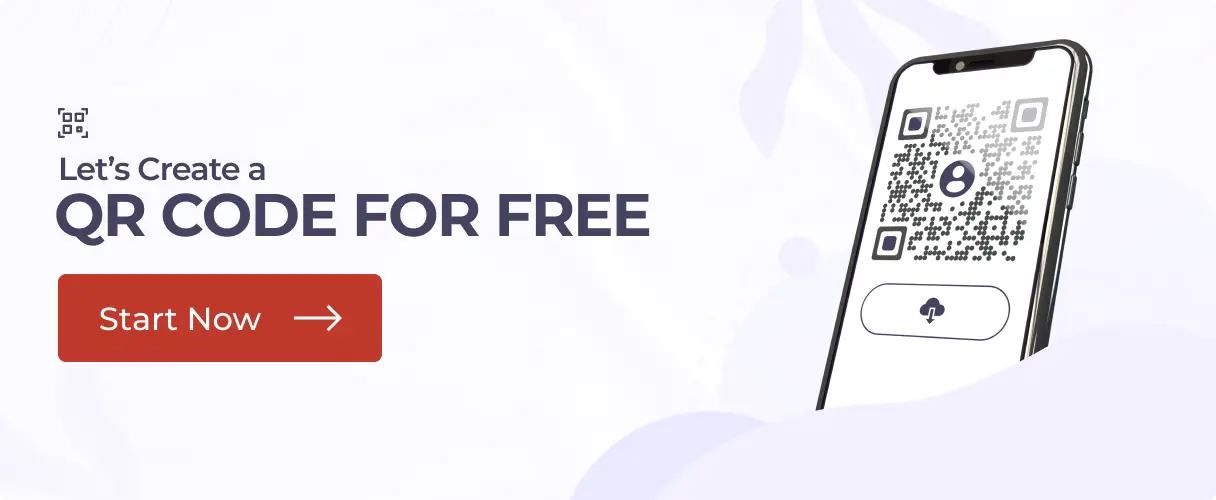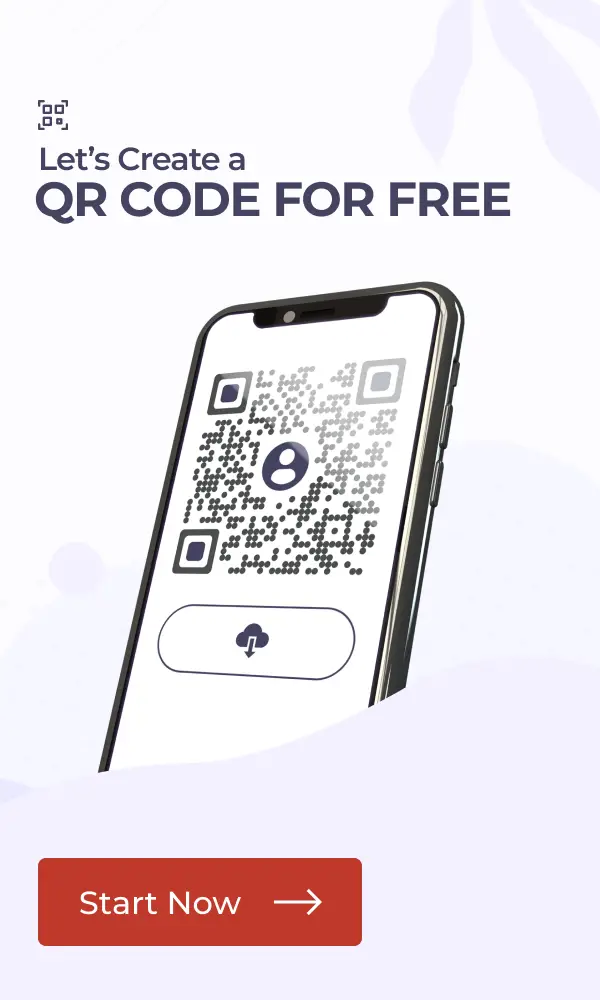In a nutshell: Transform your traditional business card into a powerful networking tool by adding QR Codes. This guide covers everything from choosing the right QR Code type (vCard vs URL) to design best practices, testing protocols, and optimization strategies. Learn to create scannable business cards that instantly share contact information, portfolios, and digital content, making networking more efficient and professional.
Traditional business cards are getting a digital upgrade, and it’s about time. With 61.4K monthly searches for QR Codes on business cards, professionals worldwide are discovering how these small squares can transform networking forever.
Imagine handing someone your business card and watching them instantly save your contact information, view your portfolio, or connect with you on LinkedIn – all with a simple phone scan. That’s the power of QR Code business cards.
Only 12% of business cards survive after the first week of contact exchange, but QR Codes change that game entirely. They eliminate manual data entry, reduce errors, and provide unlimited digital space for your professional information.
In this comprehensive guide, you’ll learn exactly how to create a QR Code for business card that actually works, avoid common mistakes that kill scan rates, and optimize your cards for maximum networking impact.
Statistics on business cards highlight that 72% of people judge a company or person based on the quality of their business card, emphasizing the crucial role in establishing brand awareness. Source: wave
A. What is a QR Code business card, and why does it matter?
A QR Code business card bridges the gap between physical networking and digital connection. QR Codes are two-dimensional barcodes that can be scanned by smartphones or QR Code readers, acting as digital gateways that link printed information to online content or actions.
Think of it as a shortcut that transforms your small business card into an unlimited digital experience.
1. The business case for QR Codes on business cards
Modern professionals face three major networking challenges:
- Space limitations: Traditional cards fit only basic contact information
- Manual errors: Recipients often mistype phone numbers or email addresses
- Lost connections: Tens of millions of business cards are printed daily, but only 12% survive the first week
QR Codes solve all these problems while adding powerful capabilities like analytics, real-time updates, and multimedia content sharing.
2. Types of QR Codes for business cards
vCard QR Codes contain your contact information directly in the code. vCard is a file format that can be opened by Apple Address Book, Google Contacts, and Microsoft Outlook, making it universally compatible.
URL QR Codes link to websites, digital business cards, or online portfolios. These offer more flexibility but require an internet connection to access content.
Dynamic vs Static QR Codes represent the biggest decision you’ll make. Dynamic QR Codes allow you to change your contact details in real-time while keeping the same QR Code, while static codes can’t be edited once created.
B. How to choose the right QR Code type for your business card?
Your QR Code choice depends on your networking goals and target audience. Here’s how to decide:
1. When to use vCard QR Codes
Choose vCard QR Codes if you:
- Want instant contact saving without internet dependency
- Have stable contact information that rarely changes
- Target older demographics who prefer traditional contact methods
- Need maximum compatibility across all devices
vCard QR Codes can be scanned by any QR Code reader and saved on any device, making them the safest choice for broad compatibility.
2. When to use URL QR Codes
URL QR Codes work best when you:
- Frequently update your professional information
- Want to showcase portfolios, work samples, or multimedia content
- Need detailed analytics on scanning behavior
- Plan to use the same code across multiple marketing materials
3. Digital business card platforms vs simple vCard generators
Simple vCard generators create basic contact cards perfect for straightforward networking needs. They’re free, fast, and reliable.
Digital business card platforms like QRCodeChimp, ME-QR, and HiHello offer advanced features:
- Multimedia content integration
- Social media linking
- Analytics and tracking
- Custom branding options
- Real-time editing capabilities
For creative professionals, consultants, and entrepreneurs, digital platforms provide significantly more value despite potential costs.
C. Step-by-step guide: How to create a QR Code for your business card

Using Scanova for a demo, here’s how you can create:
- Go to Scanova and sign up for a 14-day free trial
- From the QR Code categories, select VCard Profile QR Code
- Start customizing the landing page by adding your details—name, company, email, and phone number. You can also add additional fields such as address, social profiles, or even a description box
- Once you’ve added all the details, click Continue
- On the page that loads, enter the name of the QR Code and click Create QR Code
- Next, you’ll see the preview of the QR Code. You’ll also see the Edit Design option
- If you click on the Edit Design option, you’ll see two design options—Custom Logo and Custom Background. The custom logo allows you to add a logo and color to the QR Code. On the other hand, the custom background option allows you to place a QR Code on any image
- Once you have decided on the design or no design, click Download
- You will see a window prompting you to specify the image format and size. Note that your card designer might need the QR Code in vector formats (such as PDF and SVG), so export it in the appropriate format
Also, make sure that your QR Code is of the right size. Size affects the scannability of a QR Code. So, make sure you test it before getting it mass-printed
- Once you specify the details, click Export
That’s it. Your Dynamic Business Card QR Code is ready for use. You can even create a QR Code for a business card for free with Scanova!
D. QR Code business card design best practices
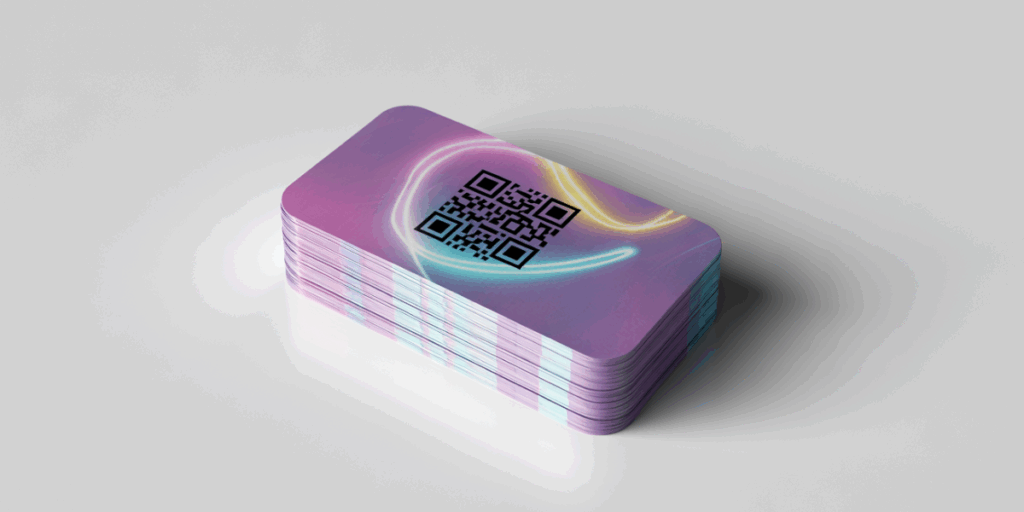
1. Size and placement guidelines
We recommend going no smaller than 2 x 2 cm (0.8 x 0.8 in) as it’s the most optimum size for the QR Code to remain scannable.
Optimal placement strategies:
- Back center: Maximum visibility without cluttering the front design
- Front corner: Prominent placement for tech-forward brands
- Side panel: Vertical card layouts with dedicated QR space
- Integrated design: QR Code as part of the overall visual composition
2. Visual design principles
Generate vibrant colored QR Codes mirroring your brand’s color scheme, adding creativity and recognition to the card.
Design best practices:
- Maintain sufficient white space around the QR Code
- Use contrasting colors for foreground and background
- Integrate relevant icons within the QR design
- Ensure brand consistency across all visual elements
- Keep designs simple to avoid scanning interference
3. Call-to-action optimization
Adding a call-to-action like “Scan me for more information” or “Scan now for exclusive discounts” makes users more inclined to interact with the QR Code.
Effective CTA examples:
- “Scan to Save Contact”
- “View My Portfolio”
- “Connect on LinkedIn”
- “Get My Digital Card”
- “See My Latest Work”
E. What information should you include in your QR Code business card?
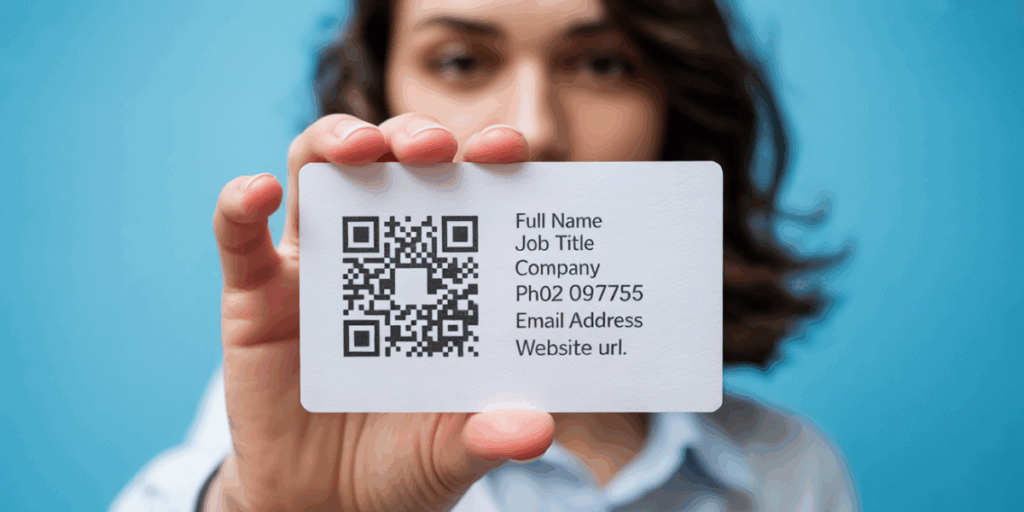
1. Essential contact information
Every QR Code business card should include:
- Full name and professional title
- Primary phone number (mobile preferred)
- Professional email address
- Company name and website
- Physical address (if relevant for your business)
2. Digital presence integration
Add web links, upload images, and add social media links you want to show on your vCard Plus display page.
Professional platforms to include:
- LinkedIn profile (essential for B2B networking)
- Company website or personal portfolio
- Professional social media accounts
- Industry-specific platforms (GitHub for developers, Behance for designers)
3. Industry-specific content ideas
Creative professionals: Portfolio galleries, work samples, creative process videos.
Consultants: Case studies, testimonials, LinkedIn profiles, booking calendars
Sales professionals: Product catalogs, demo videos, and pricing information
Service providers: Service descriptions, client testimonials, booking systems
Entrepreneurs: Company information, pitch decks, investor materials
We love that Scanova provides us with demographics/location information when we use their QR Codes in a magazine ad. This allows us to gauge interest in multiple distribution areas. Scanova allows us to access data that we can directly correlate with other analytics we have, to help deliver customers with a more accurate ROl on the service.
Marie Zecca, Satisfied Scanova Customer
F. Common mistakes to avoid when creating QR Code business cards
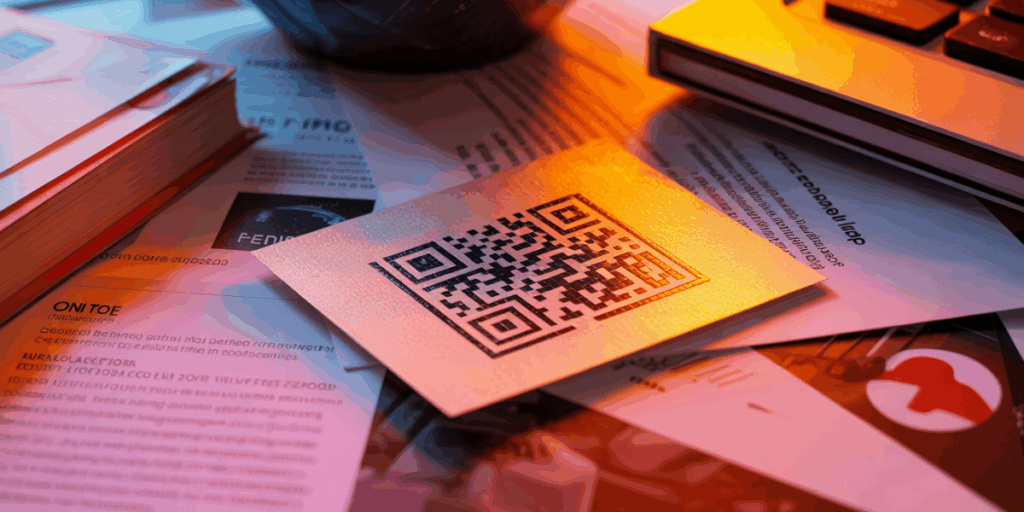
1. Technical mistakes that kill scan rates
Not testing your QR Code properly before printing can result in scanning failures and lost networking opportunities.
Critical errors to avoid:
- Insufficient testing: Skipping multi-device compatibility checks
- Poor print quality: Using low-resolution files that create pixelated codes
- Wrong sizing: Making QR Codes too small to scan reliably
- Color contrast issues: Using colors that interfere with scanning
- Broken links: Not verifying that all URLs work correctly
2. Content and strategy mistakes
Not providing necessary information or leaving out important details, such as clear word knowledge or usage, can prevent people from making informed decisions about connecting with you.
Content mistakes to avoid:
- Information overload: Including too much content that overwhelms users
- Outdated information: Failing to update contact details or offers
- Missing mobile optimization: Creating desktop-only experiences
- No clear value proposition: Not explaining why someone should scan
- Inconsistent branding: Disconnected visual identity across materials
3. Design and usability issues
Common design problems:
- Overcomplicated designs that interfere with scanning functionality
- Poor placement in areas that get damaged or hidden
- Inadequate white space around the QR Code
- Conflicting visual elements that distract from the code
- Missing call-to-action instructions
G. How to test and optimize your QR Code business card

1. Comprehensive testing protocol
Test your QR Code with multiple devices to ensure compatibility and accuracy before networking events.
Device testing checklist:
- iPhone models: Test the latest iOS versions and older devices
- Android variety: Samsung, Google Pixel, OnePlus, and budget phones
- Scanning apps: Native camera apps vs dedicated QR scanners
- Network conditions: WiFi, 4G/5G, and poor connection scenarios
2. Performance optimization strategies
Loading speed optimization:
- Optimize images for mobile viewing
- Use compressed video files for multimedia content
- Choose fast, reliable hosting for linked content
- Test loading times across different network speeds
User experience improvements:
- Create mobile-first landing page designs
- Implement clear navigation and information hierarchy
- Add “Save to Contacts” buttons for easy contact saving
- Include social media quick-follow options
3. Analytics and tracking setup
Gain valuable insights into your QR Code performance, including scan data and user behavior, with proper analytics implementation.
Key metrics to monitor:
- Total scans and unique users
- Geographic distribution of scans
- Device and operating system breakdown
- Peak scanning times and seasonal trends
- Conversion rates for specific actions
H. Advanced QR Code business card strategies
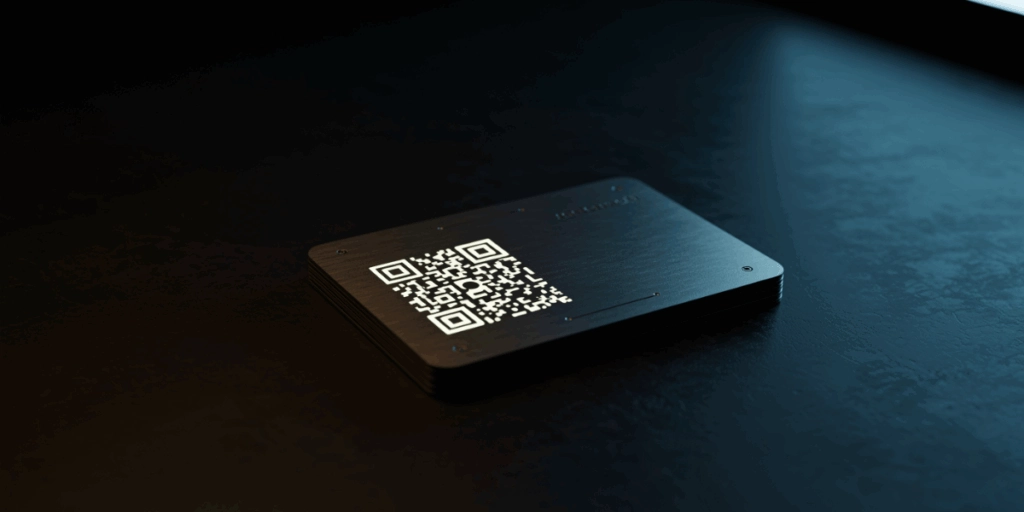
1. Multi-purpose QR Code campaigns
Event-specific optimization:
- Create conference-specific landing pages with event schedules
- Include exclusive networking offers for event attendees
- Add calendar integration for follow-up meeting scheduling
- Provide downloadable resources relevant to the event theme
Industry targeting:
- Customize content for specific industry events
- Include relevant case studies and work samples
- Adapt language and messaging for target audiences
- Feature industry-specific certifications or achievements
2. Integration with digital marketing
Cross-platform consistency:
- Use the same QR Code across business cards, email signatures, and social media
- Create unified branding across all digital touchpoints
- Implement tracking to measure effectiveness across channels
- Coordinate messaging with broader marketing campaigns
CRM and automation integration:
- Connect QR Code scans to customer relationship management systems
- Set up automated follow-up email sequences
- Track lead progression from initial scan to conversion
- Segment contacts based on scanning behavior and engagement
3. Creative implementation ideas
Create a short video introduction of yourself or your company, and link it to the QR Code for an engaging approach that adds a personal touch.
Innovation opportunities:
- Augmented reality experiences: Virtual business card overlays
- Interactive portfolios: Swipeable galleries and demo videos
- Personalized content: Dynamic content based on scanning location or time
- Gamification elements: Exclusive content unlocks or rewards programs
I. Industry-specific examples and use cases

1. Creative professionals and freelancers
Graphic designers: Link QR Codes to online portfolios, providing an interactive way to showcase work while saving space on the card.
Photographers: Gallery links with latest work, booking systems, and pricing guides
Musicians: Streaming platform links, upcoming concert schedules, merchandise stores
Writers: Published work samples, client testimonials, service packages
2. Business services and consultants
Management consultants: Case study libraries, LinkedIn profiles, consultation booking calendars
Financial advisors: Educational content hubs, appointment scheduling, and market reports
Real estate agents: Current property listings, virtual tour access, and market analysis reports
Healthcare providers: Practice information, patient education resources, appointment booking
3. Technology and startups
Software developers: GitHub profiles, project demonstrations, technical skill showcases
Entrepreneurs: Company pitch decks, product demonstrations, and investor contact information
Digital marketers: Campaign case studies, ROI examples, strategy consultation offers
SaaS companies: Product trial access, feature comparison guides, customer success stories
J. Future trends in QR Code business cards

1. Emerging technologies
NFC integration: Encode short URLs into NFC chips, allowing users to choose between scanning QR Codes or tapping for contact information.
Enhanced security: Blockchain verification and encrypted data transmission for sensitive professional information
AI personalization: Dynamic content adaptation based on scanning patterns and user preferences
Approximately 88% of business cards are thrown out within a week, but recipients keep cards with unique designs 10 times longer. Source: wave
K. FAQs: How to create a QR Code for business card

1. Do QR Codes on business cards actually work?
With 61.4K monthly searches for QR Codes on business cards and growing adoption rates, QR Codes are becoming a standard networking tool. Success depends on proper implementation, testing, and providing clear value to scanners.
2. What’s the difference between static and dynamic QR Codes?
Static QR Codes have information encoded directly in the code and can’t be changed once created. Dynamic QR Codes contain a short redirection URL that allows you to update information without creating a new code.
3. How big should a QR Code be on a business card?
The minimum recommended size is 2 x 2 cm (0.8 x 0.8 in) to remain scannable. Larger sizes work better for reliability, especially with complex designs or multiple colors.
4. Can I track who scans my QR Code business card?
Yes, with dynamic QR Codes from platforms like ME-QR, which provides analytics including scan data and user behavior insights. You can track total scans, locations, devices used, and timing patterns.
5. What should I link my QR Code to?
The best destination depends on your goals. vCard Plus QR Codes work well for contact sharing, while URL codes can link to portfolios, websites, or comprehensive digital business cards.
6. Are QR Codes secure for business cards?
QR Codes can pose security risks like malware or phishing scams, making it essential to use trusted generators and follow security best practices. Choose reputable platforms and verify all linked content.
7. Do all smartphones scan QR Codes?
Most modern smartphones have built-in QR scanning in their camera apps. Some older phones may require QR Code scanner apps, but compatibility is extremely high across current devices.
Ready to transform your networking game?
QR Code business cards represent the future of professional networking – combining the personal touch of physical cards with unlimited digital possibilities.
Start with a simple vCard QR Code to test the waters, then expand into dynamic codes with analytics and multimedia content as you see results. Remember to test thoroughly across multiple devices and always provide clear value to anyone who scans your code.
The professionals who adopt QR Code business cards now will have a significant networking advantage as this technology becomes the standard. Don’t wait for the competition to catch up – create your QR Code business card today and start making connections that actually stick.
Ready to get started? Choose Scanova for your business card needs, follow our step-by-step process, and join the networking revolution. Your future professional connections will thank you for making their lives easier.

